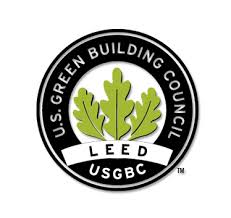
Is LEED a Green Architectural Revolution? The Comprehensive Guide to the Most Important Global Sustainability Standards
But what makes these standards different? How are buildings evaluated? And what are their economic and scientific benefits?
Construct Vision Team
6/29/202511 min read

In a world facing unprecedented environmental challenges, architecture is no longer just a visual art or a structural function; it has become a soft weapon in the battle to save our planet. Amid energy crises, carbon emissions, and declining urban quality of life, an inevitable question arises: How can buildings be part of the solution rather than the problem?
From this need, the LEED system was born—one of the most important global environmental standards that redefines what it means to be an “exceptional building.” Luxury is no longer about gleaming glass or complex structures but about efficiency, sustainability, and long-term positive impact.
But what makes these standards different? How are buildings evaluated? And what are their economic and scientific benefits?
In this article, we take you on a comprehensive journey into the heart of the LEED system—from its origins to its most advanced applications, and even its connection to the roots of sustainable traditional architecture in the Arab world, where sustainability was an inherent part of the design of our homes, courtyards, and markets.
Together, let’s discover how standards transform into a movement, and architecture into a mission.
What is the LEED System?
LEED stands for Leadership in Energy and Environmental Design, a global system for evaluating green buildings launched by the U.S. Green Building Council (USGBC) in 1998.
This system was created in response to the growing need to assess building quality not only in terms of design and comfort but also in terms of environmental impact and its ability to reduce natural resource consumption.
What sets LEED apart:
• It’s not just a design guide but a rigorous evaluation tool that awards a certification documenting a project’s compliance with environmental standards.
• It is used in over 180 countries worldwide and has become an international benchmark for excellence in sustainable urban development.
• It covers various project types:
New buildings – Renovations – Community neighborhoods – Schools – Hotels – Even airports.
The goals of LEED:
• Reduce energy and water consumption.
• Lower carbon emissions.
• Improve indoor air quality.
• Enhance user health and psychological and physical comfort.
• Better manage resources and materials.
When is a building considered to have a high LEED rating?
Each building is evaluated based on accumulated points. The more points a project earns across different sustainability categories, the higher its certification level (from Certified to Platinum).
In the next section, we’ll explain in detail how this works.
How Does the LEED Rating System Work?
The LEED Rating System & Points Structure is based on a points system distributed across several key categories related to sustainability and the quality of the built environment. During the evaluation process, a project earns points based on its compliance with specific criteria. These points are then summed up to determine the certification level, which we’ll outline below.
The core categories a project is evaluated on:
Location and Sustainability (Location & Sustainable Sites)
• Selecting a suitable site to minimize environmental impact.
• Reducing factors that affect surrounding ecosystems (such as water runoff or vegetation removal).
Water Efficiency
• Adopting water-saving systems.
• Using technologies like greywater recycling or rainwater harvesting systems.
Energy and Atmosphere
• Reducing energy consumption.
• Using renewable energy sources (such as solar or thermal energy).
• Improving heating and cooling systems.
Materials and Resources
• Using sustainable, recycled, or reusable building materials.
• Reducing waste during construction and operation.
Indoor Environmental Quality
• Improving indoor air quality.
• Using non-toxic materials.
• Ensuring natural lighting and ventilation.
Innovation in Design
• Awards additional points if the project introduces innovative solutions beyond basic requirements.
• Encourages creative thinking in space design.
Regional Priority
• Enhances focus on environmental challenges specific to each geographic region.
How to Apply for LEED Certification?
1-Register the project on the official USGBC website.
2-Submit technical documents and detailed drawings.
3-Undergo a comprehensive review by an accreditation committee.
4-Receive the certification based on the earned points.
The LEED system does not award points randomly. Instead, points for each category are determined based on several considerations:
Long-Term Environmental Impact (Environmental Impact Weighting)
Each category is evaluated based on its contribution to addressing major global environmental challenges, such as:
• Climate change.
• Biodiversity loss.
• Natural resource scarcity.
• Air and water pollution.
Example:
The Energy and Atmosphere category receives the highest point allocation (up to 33 points) because it directly impacts reducing carbon emissions and energy consumption, which are among the largest sources of environmental degradation.
Practical Applicability and Direct Impact
Categories with solutions that are relatively easy to implement in construction projects and achieve tangible results receive higher points.
Example:
Water Efficiency: Highly important in arid regions, so its weighting may be adjusted based on geographic location.
Location and Sustainability: Awards additional points if the project avoids building on environmentally sensitive land or provides public transportation access.
Regional Priority
Some points are awarded to projects addressing specific environmental issues in their geographic region. These priorities are determined by the USGBC for each region worldwide.
Example:
In water-scarce regions, additional points are awarded to projects using advanced water conservation technologies.
Innovation and Leadership
In the Innovation category, points are awarded to projects that:
• Implement solutions beyond the minimum requirements.
• Apply uncommon new technologies.
• Use innovative and sustainable operational strategies.
Strict Documentation and Application Verification
Even if a solution is environmentally sound, insufficient documentation (drawings, specifications, measurement reports) can prevent the project from earning points.
Important Notes:
The total number of points varies depending on the LEED system used:
LEED BD+C for new buildings.
LEED O+M for existing buildings.
LEED Homes for residential projects.
LEED ND for urban planning, etc.
How to Start Your Project’s Journey Toward LEED Certification?
With the complexity and diversity of LEED standards, obtaining certification may seem daunting. However, it becomes clearer when following a structured and thoughtful approach. Here are the steps to begin your journey toward a sustainable, certified project:
1-Choose the Appropriate Rating System
The nature of the project determines the LEED subsystem to follow, such as:
• LEED BD+C: For new buildings or major renovations.
• LEED ID+C: For interior space fit-outs.
• LEED O+M: For the management and maintenance of existing buildings.
• LEED ND: For new communities and neighborhoods.
2-Project Registration
The project is registered on the official LEED Online platform:
• Requires creating an account on the USGBC website.
• Registration fees vary depending on the project type and company membership. Each LEED system has specific fees, which differ if the registering entity is a USGBC member.
This includes: specifying the project’s location, area, and function, as well as identifying the owner and accredited consultants.
3-Set Target Points and Collect Documentation
• Analyze environmental potential and budget to determine achievable points.
• Develop an action plan for each evaluation category, with a mechanism for documenting achievements.
The project team begins collecting data, calculations, and models that prove eligibility for each point. Documentation may include:
-Energy performance analyses.
-Waste management plans.
-Documentation of sustainable material sources.
-Proof of air and water quality.
4-Document Procedures and Submit
• Gather all evidence, reports, and plans proving compliance with each point.
• Upload to the platform for evaluation by the LEED committee.
5-Review and Certification
• The project first undergoes a preliminary review known as the Review & Appeal Process.
• Points can be modified or completed before the final review within 25 days (maximum without additional fees).
• Certification is issued based on the final point total.
It is recommended to form a Sustainability Team comprising: an architect, mechanical/electrical engineer, certified LEED AP, and sustainability consultant (if available). This team ensures the required points are achieved through integrated design and implementation, though it is not mandatory for application.
What Are the LEED Certification Levels?
The LEED system is based on a points-based evaluation. Each certification level reflects the building’s commitment to sustainability standards. Depending on the points earned through applying various criteria, a project is awarded one of the following four levels:
LEED Certification Levels:
LEED Certified 40–49 Points The minimum level of commitment to sustainable practices.
LEED Silver 50–59 Points A higher level reflecting noticeable improvements in efficiency.
LEED Gold 60–79 Points An advanced level demonstrating a strong commitment to sustainability.
LEED Platinum 80 Points and Above The highest possible rating, reflecting excellence in all aspects of green design.
What is the Purpose of This Gradual System?
This tiered system allows for:
• Encouraging competition among projects to achieve better environmental performance.
• Providing flexibility for companies and institutions to choose goals that suit their budgets and circumstances.
• Promoting continuous development, as projects strive to move from one level to another in later stages.
How Does LEED Rating Variation Reflect on the Project?
Each LEED rating level is not just an aesthetic or environmental classification but directly impacts the project’s reputation, market value, and investment appeal. Here’s how the variation in rating affects the project:
• LEED Certified (40–49 Points): Indicates a basic commitment to environmental practices but does not significantly improve energy efficiency or reduce environmental impact. Its moral and marketing impact is relatively limited.
• LEED Silver & Gold (50–79 Points): These levels confirm the presence of clear strategies to improve air quality, water and energy consumption, and resource management, enhancing user and investor confidence in the project.
• LEED Platinum (80+ Points): Considered a prestigious distinction, making the project a benchmark for sustainability. It attracts global companies, academic institutions, and environmentally conscious users. Often, it receives government privileges, financing facilities, and higher community appreciation.
The rating variation also affects:
• Long-term operating costs: Higher ratings reduce energy consumption and maintenance costs.
• Lease or sale potential: Higher-rated buildings are leased and sold faster and at higher values.
• Regulatory compliance: In some cities, certification may be a requirement or offer incentives.
Sustainability Is Not a New Concept: Our Roots Were Pioneers
Although the LEED system may seem modern and globally developed, the philosophy of sustainability is not entirely imported. In fact, it can be seen as a cultural extension of what our ancestors practiced intuitively in traditional architecture.
In ancient Arab cities, from Sanaa to Cairo, and from Fez to Baghdad, sustainability was the norm, not the exception:
• Use of local materials (clay, stone, wood) to achieve environmental balance and reduce the carbon footprint.
• Natural ventilation through courtyards, studied openings, and windcatchers.
• Passive shading via mashrabiyas, thick walls, and careful solar orientation.
• Rainwater harvesting systems for irrigation and cleaning.
What standards like LEED do today is reformulate these principles into scientifically measurable and internationally evaluable frameworks, adding modern elements and technologies: energy efficiency, smart systems, advanced insulation techniques, and life-cycle analysis of buildings.
Recognizing, preserving, and developing these roots not only enriches the design experience but also strengthens the sense of belonging to an authentic Arab architectural identity. We are not importing sustainability from the West but rediscovering it in a contemporary language.
Therefore, when we adopt LEED or other environmental assessment systems, we are not just aligning with a responsible global trend but continuing a centuries-old narrative of harmony between architecture, environment, and humanity.
Prominent Examples of LEED-Certified Projects
Bank of America Tower – New York
• Rating: LEED Platinum, System Used: LEED for Core & Shell
• Key Features:
Rainwater and air conditioning water recycling system.
High-efficiency glass for heat and light insulation.
Significant reduction in carbon dioxide emissions.
Consumes 50% less energy than conventional buildings.
Masdar City – Abu Dhabi, UAE
• Rating: Several buildings within the city have achieved LEED Platinum, System Used: LEED for Neighborhood Development
• Key Features:
Fully reliant on solar energy and sustainable transportation.
A low-carbon smart city.
Preserves Gulf architectural heritage with advanced technological solutions.
Systems to reduce water consumption by 54%.


Why Is It Important for Architects and Engineers to Master LEED Standards?
LEED standards are no longer just an "optional extra" but have become a fundamental requirement in major international projects and for both public and private entities. Here’s why familiarity with them is crucial:
Competitive Advantage in the Market
An architect or engineering firm with LEED certification or expertise enhances their chances of winning international project contracts, especially those funded by organizations or governments focused on sustainability.
Comprehensive Understanding of Sustainable Architecture
Learning LEED goes beyond application; it provides an integrated understanding of environmental, energy, water, and social factors that impact buildings.
Active Participation in Shaping the Future of Cities
With increasing climate change and urban expansion, the role of architects and engineers becomes critical in creating resilient and sustainable urban environments. LEED standards offer a practical tool to achieve this.
This encourages designers to think about the impact of their designs on society and the city:
Does it provide accessibility for people with disabilities?
Does it support sustainable mobility?
Does it use water and resources equitably?
Staying Updated with the Latest Building Solutions and Technologies
During the evaluation process, designers become familiar with the best low-carbon local materials, high-efficiency ventilation and lighting systems, and smart control systems.
This provides an opportunity for new experiences and an open laboratory for learning and professional growth.
LEED standards do not restrict creativity but guide it toward intelligent and functional use of materials, energy, light, and water, both aesthetically and practically.
Architects work with other disciplines under a unified vision from the project’s early stages.
Deeper Understanding of the Relationship Between Design and Performance
LEED forces designers to think about what happens after construction:
How will users interact with the space?
Will it consume more energy than necessary?
Will the design impact user health?
An architect doesn’t just design a building but designs a sustainable experience.
Criticisms of the LEED System: Is It Enough on Its Own?
Despite its widespread global success and adoption in thousands of projects, LEED has faced criticisms and limitations that deserve consideration, especially when compared to other sustainability assessment systems.
Key Criticisms:
Focus on Design Over Actual Performance
While a project may achieve a high rating during the design phase, its actual performance after operation may not reflect the same level. Points do not always guarantee operational efficiency or low actual consumption.
Strategic Point Accumulation Without Substantial Improvement
Some points can be achieved relatively easily without significantly enhancing the project’s sustainability, allowing focus on "what raises the rating" rather than what truly serves the environment and society.
High Registration and Certification Costs
Some small projects or those in developing countries may not be able to afford the registration, documentation, and auditing fees required for certification.
Brief Comparison with Other Systems:
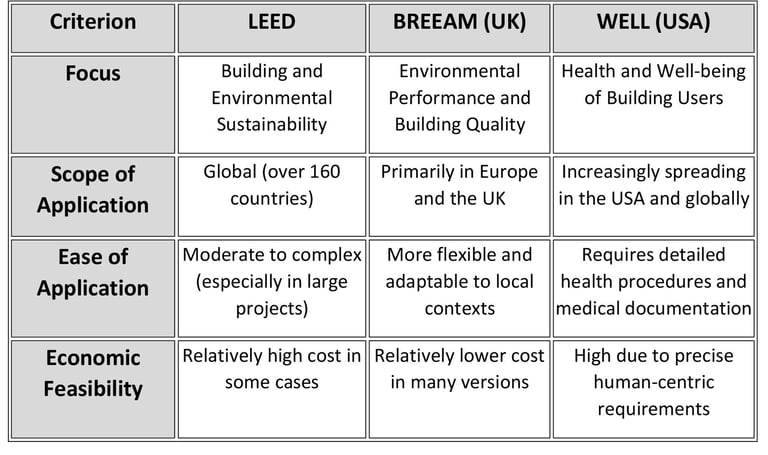

Share the post
Subscribe to our newsletters:
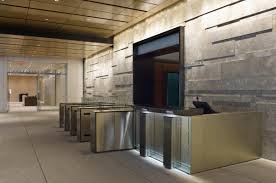

Hamad International Airport Expansion – Qatar
• Rating: LEED Gold (with some facilities expanding to Platinum), System Used: LEED for New Construction
• Key Features:
Dynamic design inspired by traditional architecture.
Advanced natural lighting and ventilation solutions.
Reuse of local materials and natural resources.
Strict waste management programs.
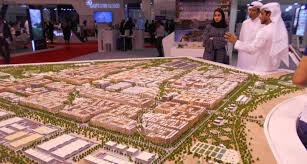

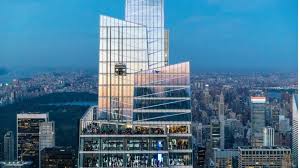

Is LEED Alone Enough?
The short answer: Not always.
It depends on the project type, user priorities, and the surrounding environment. For example:
• A large urban project might require LEED + WELL to ensure both environmental and health standards.
• A residential building in Europe might find BREEAM more adapted to local regulations.
• Meanwhile, a cultural or heritage building might need customized solutions outside conventional classifications.
However, LEED remains a strong starting point and a global reference for those entering the world of green design professionally and methodically.
Conscious Design Is Not an Option… But a Necessity
Sustainability in design is no longer an intellectual luxury or an elitist choice but a professional and ethical necessity for every architect and engineer striving to build a fairer and more efficient world.
Numbers Speak:
• According to the U.S. Green Building Council (USGBC), LEED-certified buildings generally:
Use up to 25% less energy.
Consume nearly 11% less water.
Emit up to 34% less carbon compared to conventional buildings.
• Over 100,000 LEED-certified projects have been registered in more than 180 countries, covering an area exceeding 3 billion square meters by 2024.
All these numbers represent a real impact on our planet, but they start with the decision of a single designer to choose sustainability consciously.
If you’re an architect or engineer aiming to leave a lasting impact, understanding and applying genuine sustainable standards gives you a global common language in design and places you among an elite group of professionals who build not just for the present but for the future.
Whether you’re starting your career or seeking to enhance your design footprint, investing in deep knowledge of these standards is an investment in the environment, people, and yourself as a maker of space.
